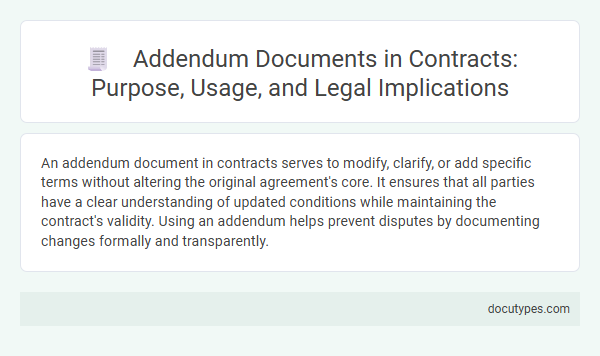An addendum document in contracts serves to modify, clarify, or add specific terms without altering the original agreement's core. It ensures that all parties have a clear understanding of updated conditions while maintaining the contract's validity. Using an addendum helps prevent disputes by documenting changes formally and transparently.
Understanding Addendum Documents in Contract Law
An addendum document serves to modify, clarify, or add specific terms to an existing contract without changing the original agreement entirely. Understanding addendum documents in contract law ensures that all parties recognize adjustments legally and transparently, preventing disputes. You can use an addendum to address changes like deadlines, payment terms, or scope of work while maintaining the contract's validity.
Purpose of Addendums in Contractual Agreements
| Aspect | Description |
|---|---|
| Definition of Addendum | An addendum is a supplementary document attached to the original contract to modify, clarify, or add new terms after the contract has been executed. |
| Purpose of Addendums | Addendums serve to update or change specific contract provisions without drafting a new agreement, ensuring flexibility and adaptability in contractual relationships. |
| Common Uses | Typical uses include extending deadlines, altering payment terms, adding additional scope of work, or correcting errors in the original contract. |
| Legal Significance | Once signed by all parties, an addendum holds the same legal weight as the original contract and becomes an integral part of the contractual agreement. |
| Benefits | Facilitates contract management by avoiding complete renegotiation, saves time and resources, and promotes clear communication between parties. |
Common Scenarios for Using Contract Addendums
An addendum document in contracts serves to modify, clarify, or add terms without rewriting the entire agreement. It ensures that all parties acknowledge changes and maintain a clear record of adjustments.
- Extending Deadlines - An addendum can specify new timeframes when project timelines change or delays occur.
- Adjusting Payment Terms - Modifications in payment schedules or amounts are often captured through a contract addendum.
- Adding New Deliverables - When additional services or products are included, an addendum formally incorporates these into the original contract.
Your contract remains enforceable and up-to-date by using addendums to reflect evolving agreements.
Legal Requirements for Valid Addendum Documents
What is the purpose of an addendum document in contracts? An addendum clarifies, modifies, or adds terms without altering the original contract. It ensures all parties have a clear, updated agreement recognized by law.
What are the legal requirements for a valid addendum document? Your addendum must be written, signed by all parties, and reference the original contract. Compliance with local contract laws guarantees enforceability in legal proceedings.
Drafting an Effective Contract Addendum
An addendum in a contract serves to modify, clarify, or add specific terms without altering the original agreement. It ensures all parties formally acknowledge changes, maintaining legal validity and preventing disputes.
Drafting an effective contract addendum requires precise language and clear identification of the original contract details. Including the date, parties involved, and specific clauses being amended enhances clarity and enforceability.
Difference Between Addendums and Amendments
An addendum in contracts serves to include additional terms or information without altering the original content of the contract. It is a separate document that supplements the initial agreement.
- Addendum - Adds new clauses or details to the contract without changing the original terms.
- Amendment - Modifies or revises existing contract terms and conditions.
- Legal Impact - Both are legally binding but serve different functions in contract management.
Risks and Challenges of Using Addendums
An addendum document modifies or clarifies terms within an existing contract, ensuring both parties agree to the changes without drafting a new contract. Risks of using addendums include potential misunderstandings, conflicting terms, and incomplete integration with the original agreement. Your failure to review addendums carefully can lead to legal disputes and unintended contractual obligations.
How Addendums Affect Original Contract Terms
An addendum document serves to modify, clarify, or add specific terms to an existing contract without altering the original agreement entirely. It ensures that both parties agree to the new provisions while maintaining the enforceability of the initial contract.
Addendums affect original contract terms by legally integrating new clauses or changes, which become binding once signed by all involved parties. They can expand the scope, adjust deadlines, or update payment terms, reflecting the evolving needs of the contracting parties. This process preserves the contract's validity while allowing flexible amendments without drafting a new contract from scratch.
Enforceability and Legal Implications of Addendums
An addendum document in contracts serves to modify, clarify, or add specific terms without altering the original agreement entirely. It ensures that new agreements or changes are legally recognized and incorporated into the contract.
The enforceability of an addendum depends on proper execution, including signatures from all involved parties. Legally, an addendum holds the same weight as the original contract, protecting your interests by updating obligations or conditions clearly.
What Is the Purpose of an Addendum Document in Contracts? Infographic

